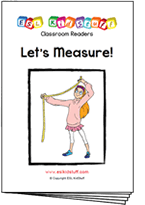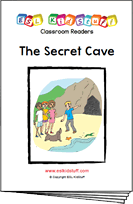Measuring parts of the body lesson plan
Stand-alone lesson ESL kids lesson plan
Lesson plans for ESL kids teachers
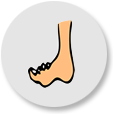
Measuring parts of the body
In this lesson students practice measuring parts of the body using large numbers and adjectives to describe size. Students review body vocabulary and large numbers (1-150), do lots of energetic activities, measure with rulers or tape measures, sing a song and do a worksheet.
Members get accompanying flashcards, worksheets, song and classroom reader.
Download materials:
Our lesson plans are FREE!
Sign up for accompanying:
✔ worksheets
✔ homework sheets
✔ craft sheets
✔ flashcards
✔ song downloads & videos
✔ classroom readers & videos
Click to see lesson details, materials and supplies
Time: 40 mins – 1 hour 30 mins
Objectives: Reviewing parts of the body, using large numbers (0 to over 100), using adjectives to describe size (long, tall), comparing size (the tallest, the shortest, the longest).
Structures: “I am / You are … com tall”, “My/Your (hair/arms/etc.) is/are … cm long”, “How tall am I?”, “How long is my …?”, “I am / He/She is … the tallest/shortest”, “My/His/Her … hair/arms/etc … is/are … the longest / the shortest”.
Target vocabulary: tall, short, long, the tallest, the shortest, the longest, centimeters (cm), hair, arms, nose, hands, legs, feet.
Lesson materials
Flashcards:
- head, shoulders, knees, toes, eyes, ears, mouth, nose, hair, arms, hands, legs, feet.
Printables:
- Measuring worksheet
- Measure yourself and your family! worksheet
- Reader worksheet
- Head, shoulders, knees & toes song poster
Songs:
- Head, shoulders, knees & toes
Readers:
- Let’s measure!
Additional materials:
- Measuring parts of the body vocab crossword
- Measuring parts of the body vocab word search
- More measurements worksheet
Supplies:
- [hide_on_uk]colored[/hide_on_uk][hide_on_us]coloured[/hide_on_us] pencils
- small balls
- rulers or tapes measures (one per pair of students)
- stop watch or timer
- board with marker / chalk
- device to play the song on
In this lesson students will use practice measuring parts of their bodies using rulers or tape measures. As students will be reviewing body vocab and numbers vocab this lesson should come after the Parts of the body lesson and large numbers (up to 150) should have also been taught.
Lesson procedure:
Warm up and maintenance:
The beginning of your lesson is extremely important: this is where you set the tone of your lesson and get everyone in the right frame of mind for learning English. It is also an opportunity to check homework and review previous lessons.
Click for warm up suggestions for the start of your lessons
These activities can be done in the following order at the start of your lesson:

1. Greetings and name tags
Greet the students by name as they enter the classroom and gesture for them to sit down. Before class prepare some blank name tags (stickers or pin-on tags). Give these out and have everyone write their names and put their tags on. If you use pin-on tags, you can keep and give out every class.

2. Homework check
Check each student’s homework set in the last lesson. Ask each student some questions about their homework worksheet (e.g. “what [hide_on_uk]color[/hide_on_uk][hide_on_us]colour[/hide_on_us] is it?”), give lots of praise, and then put some kind of mark on the homework sheet (e.g. a sticker, a stamp or draw a smiley face). Finally, tell your students to put their homework back into their bags.
3. Review past lessons
Reviewing past lessons is very important – students need constant practice of new vocab, structures, songs, games and so on. Always review parts of your last lesson as well as some parts from other previous lessons. You can spend 5-10 minutes reviewing – it’s fine to recycle games and activities from your past lessons to review as kids enjoy playing familiar games (although be careful not to play a game to death!). See the section “Other ideas to include in your warm” below for ideas.
You can also include review activities in the main body of your lesson. Kids can have short attention spans so it’s good to be able to pull out lots of activities during different stages of the lesson.
Other ideas to include in your warm up:
Ball pass questions
This is good to review questions from previous lessons. Get everybody standing in a circle.
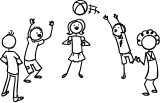
Round 1:
Take a ball and hold it and say, “My name is (you name)”. Then throw the ball to one student and say, “What’s your name?”. Students throw the ball around randomly, saying their names and asking for names.
Round 2:
This time ask a review question, e.g. “How many tables are there?”. Then throw the ball to a student who should answer, “There are (6) tables”. Help if necessary. Then that student throws the ball to another student and asks a “How many …?” question. Continue so everyone has a go. You can have multiple rounds with different topic questions.

Play “Spin the bottle”
Sit students in a circle with a bottle in the middle. Teacher spins the bottle. When it stops spinning the student it is pointing to has to answer a question. If the answer is correct then that student can spin the bottle. This is a good class warm up activity (e.g. How are you? What’s your [hide_on_uk]favorite[/hide_on_uk][hide_on_us]favourite[/hide_on_us] food? How’s the weather today?, etc.
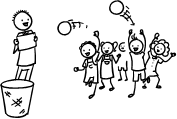
Play “Vocabulary basketball”
This is a fun game which reviews vocabulary from previous lessons. You will need a basket (a trash can) and 2 balls (or 2 pieces of A4 paper scrunched up into balls).
Form 2 teams and line them up so that two players from each team are facing the front with the basket in front of them. Let both players throw their ball – if they get their ball into the basket they can try and win a point by giving the correct answer to a question the teacher asks. This can be an actual question (e.g. What are you wearing?) or a flashcard (What’s this?). Then they go to the back of the line. At the end, the team with the most points is the winner!
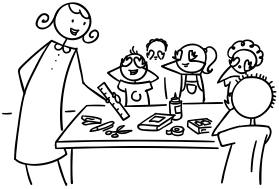
Play “What’s missing?”
This is a fun review memory game – students will have to try to remember review objects from previous lessons (e.g. classroom stationery). Lay the objects out on a table for all to see. Allow the students a minute to memorize the positions of the objects. Remove an object and hold it behind your back. Say, “Open your eyes!” – the first student who can shout out the missing object wins a point for his/her team. Play for all the objects.
Finally, calculate which team has won the most points and give them a round of applause.

Play “Quiz game show”
This is a fun quiz game, like a simple version of a TV game show. Draw some circles on the board and randomly write numbers 1, 2 or 3 in each circle. These will be points.
Put students into teams. Then ask the first team to choose a number – 1 is an easy question (e.g. “Do you like bananas?”) and 3 is a difficult question (e.g. point at a clock and ask, “What time is it?”). 2 will be in between in terms of difficulty. When the question has been answered correctly, erase that number circle. Play until all the number circles are gone – the team with the most points is the winner!
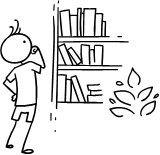
Read a classroom reader again
As you progress through the lessons you will start to build up a catalog of classroom readers (see our Readers download page at https://www.eslkidstuff.com). Kids love going back to old stories and reading through them again. Invite a student to pick a classroom reader and read through it as a class. Make the story as interactive as possible by asking questions (e.g. what [hide_on_uk]colors[/hide_on_uk][hide_on_us]colours[/hide_on_us] there are, the names of different objects, etc.) and getting students to speculate what is going to happen next in the story.
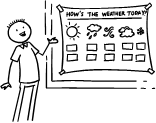
Talk about the weather (do after you have taught the weather lesson plan).
- Prepare a weather board. Before the first class prepare a piece of cardboard and cover it with felt – you are going to pin this to the wall. If you can, try and get blue felt (to represent the sky). Write at the top in large letters, “How’s the weather today?”. Below that write “Today it’s”. Cut out weather pictures (such as our weather flashcards) and stick some velcro on the back. Arrange the weather pictures around the edge of the board and then put the board on the wall of your classroom. You can now use this weather board at the beginning of every lesson.
- Ask about the weather. Ask, “How’s the weather today?” and have students put up their hands. Allow one weather condition per student (e.g. “It’s rainy”) and have each student come up and put a weather picture on the weather board.
- Introduce more weather vocabulary. Depending on weather conditions, you can introduce more weather words (with pictures … you can get students to draw them), such as:
- stormy
- misty
- showery
- freezing
- humid
- frosty
- icy
- drizzly
New learning and practice:
Review parts of the body:
We’ll start with some quick, fun activities to review parts of the body:
1. Play “Body flashcards fun”
Before class print off the following flashcards: head, shoulders, knees, toes, eyes, ears, mouth, nose, hair, arms, hands, legs, feet. Start by quickly showing each card and having students shout out the answers. For any vocabulary students are unfamiliar with, chorus the word 3 times.
Next, deal out the cards to students in the class – for large classes you may need duplicates of the cards to make sure everyone has one; for smaller classes, deal out all of the cards – it is fine if students have 2 or more cards each. Shout out a vocabulary word and an exercise or action, such as, “Eyes – jump 5 times!” – students holding the “eyes” flashcard must do the action. Other actions can include:
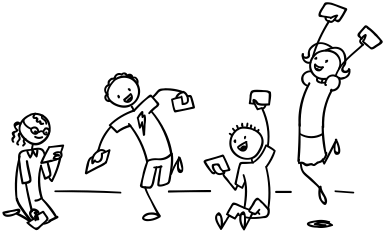
- run around the classroom
- star jump 5 times
- say the alphabet a-z
- sing a song
- turn around 5 times
- stand on 1 leg
- hop
- etc.

2. Play “Body touch race”
Put students in pairs – you are going to say body vocabulary and students are going to race to be the first to touch that part on their partner’s body. For example, Teacher says, “Touch your partner’s arm!” and each pair must try to touch their partners arm before getting their arm touched. It is great fun and quite frantic – in order to work well, make sure the following rules are explained first:
- no slapping or hitting – only soft touches are allowed
- students cannot move more than one step away from each other
- teacher: do not include “eyes” in this game or you may end up with injuries!!
3. Sing the “Head, shoulders, knees & toes” song
Your students should have sung this song lots of times by now, so this is a bit of quick fun. Get everyone standing in a line and touching their bodies as they sing along.
[hide_on_uk]Short sample (members get full-length song):
[/hide_on_uk]
[hide_on_us]Short sample (members get full-length song):
[/hide_on_us]
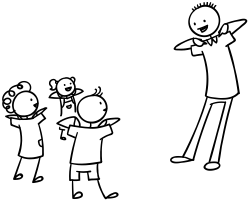
4. Play “Teacher says”
This is the game “Simon says” but using the word “teacher”, or your name, instead. Go straight into the game (no explanations necessary) by saying, “Teacher says touch your (knees)”. Do the action and make sure everyone else follows along. Do a few more, “touch your eyes, touch your toes”, etc.
Then at some point give a command without the “Teacher says” part (e.g. “Touch your mouth”). First time round, everyone will touch their mouth, so make it very clear that they shouldn’t do this when you don’t say “Teacher says”. After a while your students will get the hang of it. Play the game faster and faster. When a student makes a mistake they have to sit the rest of the game out. The last student standing is the winner.
Review large numbers (1 -150):
In order to measure themselves, students will need to be familiar with large numbers (of up to 150). If your students have never learned large numbers you will need to spend some time before this lesson teaching these numbers. In this lesson plan we assume your students have had some class time practicing large numbers.
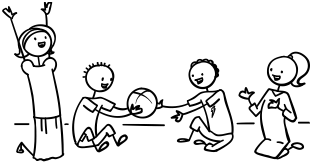
5. Play “Ball pass counting race”
Divide the class up into groups of around 4-8 students (try and have at least 2 groups – although for small classes just one group is fine). Each group should sit in a circle. Each group will pass the ball around the circle and count numbers 1 to 150 as they pass. The first group to finish is the winner. As the activity is running, walk around and listen – any mistakes you hear will mean the team must restart at 1 again.

6. Play “Circle the number race”
Next, write random numbers (from 1 to 150) all over the board. Divide the class into 2 teams and line up each team, students standing behind each other, so that the front person in the line is facing the board. The first two players on each team will race to circle the number the teacher shouts out to win a point for their team – e.g. the teacher shouts “128!” – both players run to the board, pick up a marker or chalk, and try to circle the number first. They then join the back of their team’s line and the next 2 players race.
7. Play “Write the number race”
This is very similar to the above activity, however this time students race to the board to write the correct number: Teacher shouts a number (e.g. “68!”) and the two players race to the board, pick up a marker or chalk and write the number. The first player to write the correct number wins a point for their team.
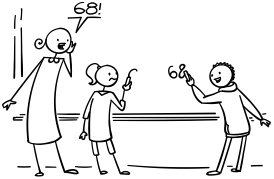
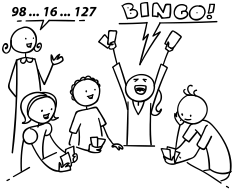
8. Play “Numbers bingo”
Great fun! Give everyone a piece of paper and tell them to draw a grid (of 5×5 or 8×8, etc. – depending on how long and difficult you want the game to be). Then get students to write any numbers they like (from 1 to 150) in each cell until they filled in their grid. The teacher will be the number caller – to keep things simple, write down numbers on a piece of paper as you randomly call them out. Students can win points, stars, stickers or prizes for getting lines and full houses.
Measuring parts of the body:
Now that the key vocabulary has been reviewed we can move onto the fun part of the lesson – measuring parts of the body.

9. Model how to measure
Have everyone sit down, facing the board. Hold out your arm and take a tape measure or ruler. Attempt to measure your arm but make it obvious that it is too difficult to do by yourself. Then ask for a volunteer to help you. Get your volunteer to measure your arm and ask, “How long is my arm?”. Elicit the number and then teach the word “centimeters”. Write on the board “My arms are (73) cm long”.
Then ask for another volunteer to help you measure your hair and write the sentence on the board (e.g. “My hair is 20 cm long”). Continue with different volunteers helping to measure different parts of your body as shown in the worksheet Measurements worksheet. By the end you should have 7 sentences written on the board (the same ones as on the worksheet).
10. Pairs measure each other and complete “Measurements” worksheet.
Put everyone in pairs and give each student a worksheet. Pairs work together to measure each other and fill in their worksheets. Encourage everyone to say the measurements rather than just showing on the ruler or tape measure. Also encourage the use of structures, such as (write on the board):
- “How tall am I?”
- “How long is my …?”
- “You are … cm tall”
- “Your … is/are … cm long”

11. Play “Compare results line up”
Now that everyone has completed their worksheets with their measurements we are going to find out who in the class is the tallest, shortest, has the longest and shortest body parts … in a fun ‘line-up’ game.
Tell your class they have to stand in a line with the tallest at one end and the shortest at the other end (and everyone else standing in order of height between). This is quite easy to do by sight, so your students should be able to do this without referring to their worksheets. Get them to do it as quickly as possible and set a time limit (e.g. 30 seconds on a timer or stop watch). Then write on the board (under the title “Class measurements”):
Mika is the tallest.
Luis is the shortest.
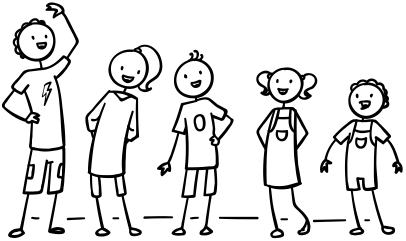
Next, tell everyone to arrange themselves in terms of foot size … this is not so easy to do by sight, so everyone will have to work together using their worksheets to determine the correct order. Again, give a time limit (e.g. 1 minute). Then write on the board:
Hugo has the longest feet.
Ana has the shortest feet.
Continue with all of the other measurements on the worksheet, writing up the results on the board.
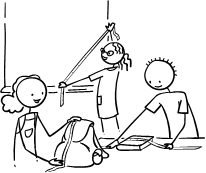
If you have time, you can get your students to measure things in the classroom and write their results down on the board. Give each pair a few items to find and measure, so that each pair measures different things. Each pair writes the results onto the board as they measure each item, such as:
- A book is 20 cm long
- The window is 200 cm long
- My bag is 45 cm long
- etc.
12. Read classroom reader “Let’s measure!”
We’ll finish with a reading activity which reviews all parts of this lesson in a fun and educational way. Before class, download and print off the reader “Let’s measure!” and the reader worksheet. As you go through each page, get everyone to say their measurements (they can measure themselves as you go through the reader) and write their measurements on their worksheets. Then get everyone to shout out their guesses for the animal measurements. For example:
Teacher: (reading from page 2) “Ok. How tall are you?”
Students: 132cm! 143cm! 127cm! etc. (everyone shouting out their height)
Teacher: OK! Write your height on your worksheet. (reading) “And how tall do you think a giraffe is?”. Ken, what do you think?
Ken: Um, 300cm?
Teacher: Maybe. How about you Maria, what do you think?
Maria: Um, 400 cm?
Teacher: Ok, everyone write your guess on your worksheet. (turning to page 3 and reading) “An average giraffe is about 600cm tall!”. Wow! That’s really tall! (students write the actual height on their worksheets).
Get the students really involved by asking them lots of questions and encouraging them to shout out their measurements and guesses.
Alternatively, watch our video version of the reader (Internet connection required).
Wrap up:
Assign homework: “Measure yourself and your family!” worksheet
Click for wrap up suggestions for the end of your lessons

1. Assign homework
Each week give out a homework worksheet for your students to take home. Hold up the homework worksheet and model how to do it. Give out the worksheets and say, “Put your homework in your bags”.

2. Do “Quick check”
Time to leave the class. Make sure everything is put away and the students have gathered their belongings. Have them line up at the door and place yourself between the door and the students. For each student check one new word or phrase, for example:
- hold up an object or flashcard (such as an item of clothing) and ask, “What’s this?”
- ask a question from the lesson (e.g. “Where do you live?”, “Do you like bananas?”, “Can you play chess?”, etc.)
When they give you the correct answer say goodbye and let them leave. If their answer is wrong, have them go back to the end of the line – they will have to try again once they reach the front!
Other lesson plans
Actions, verbs & tenses:
- Can – for ability
- Morning routines
- Daily routines & times of the day
- Actions – Present continuous
- Future plans using “going to”
- Past tense activities – Regular verbs
- Past tense activities – Irregular verbs: Part 1
- Past tense activities – Irregular verbs: Part 2
Adjectives:
- Describing people
- Describing things
- Comparing things (Comparative adjectives)
- Comparing things (Superlative adjectives)
Adverbs:
Alphabet:
Animals:
Body:
Classroom:
Clothes:
Colors:
Colours:
Directions:
Family:
Feelings & emotions:
Food:
Health & sickness:
Holidays & festivals:
Jobs:
Likes, dislikes & favorites:
Likes, dislikes & favourites:
- Likes & dislikes
- [hide_on_uk]Favorites[/hide_on_uk][hide_on_us]Favourites[/hide_on_us] and asking why
Nature & Our world:
Numbers:
Places & where we live:
Prepositions of location:
Pronouns:
Shapes:
Shopping:
Sports:
Time, days, months, seasons:
Toys:
Transport & travel:
Weather:


